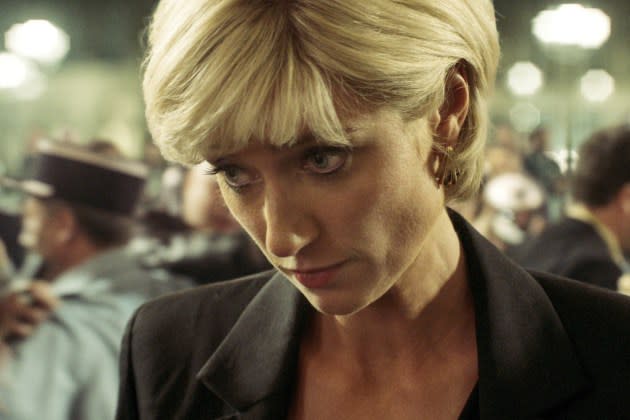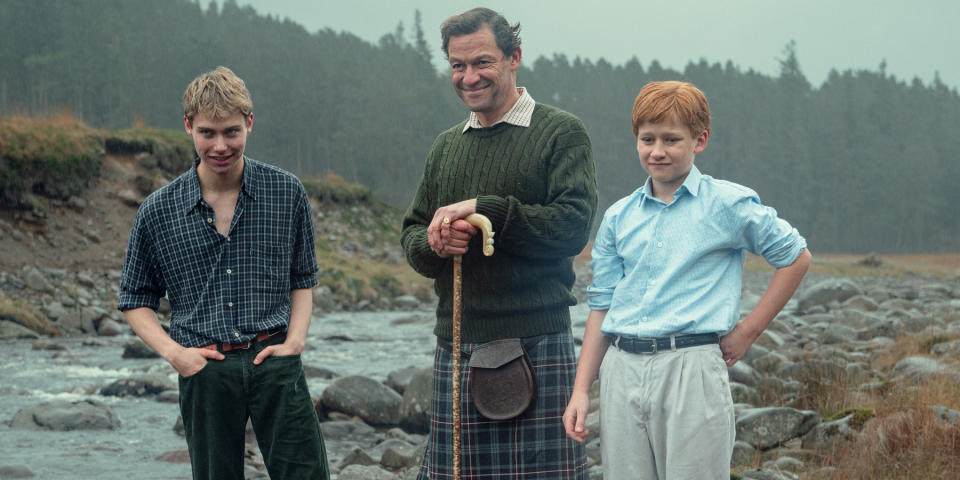‘The Crown’ Struggles Mightily With Princess Diana’s Death
- Oops!Something went wrong.Please try again later.
- Oops!Something went wrong.Please try again later.
- Oops!Something went wrong.Please try again later.
- Oops!Something went wrong.Please try again later.

The 2006 film The Queen, written by Peter Morgan, dramatizes the immediate aftermath of the death of Princess Diana. Much of the conflict comes from Queen Elizabeth’s reluctance to publicly address the grief of her subjects, with British Prime Minister Tony Blair pleading with her to speak.
In the fourth episode of the sixth and final season of The Crown, Morgan finds himself essentially remaking his earlier film. Only this time, the anguished voice of the people is not Blair, but Prince Charles. It’s a telling choice, less indicative of a writer not wanting to repeat himself than of Morgan’s shifting attitude toward the royals since The Queen was released. That movie, and even the early days of The Crown, treated the monarchy with at least as much skepticism as affection, if not more. Over the years, though, the scales have tipped increasingly in the favor of the House of Windsor, and particularly to certain members of it. The show is not blind to the faults of the royal family as both institution and as individuals. But it long ago stopped feeling as if Morgan was writing about them with a pure outsider’s perspective. Now he comes across as an explorer who has gone native. While the series has in the past treated various prime ministers as characters with equal narrative weight to most of the royals, Blair is an afterthought here. This is a conflict between queen and prince, rather than aristocrat and civil servant, because Prince Charles has improbably become the tragic hero of The Crown.
More from Rolling Stone
Daniel Radcliffe's Moving Tribute to His Paralyzed 'Potter' Stunt Double David Holmes
'Rustin': Hollywood Finally Gives a Great American Hero His Due
'Scott Pilgrim' Is Back for More, and Edgar Wright Is Over the Moon
Netflix is splitting this final season in half. The first four episodes, covering the weeks immediately before and after the car crash that killed Diana (played again by Elizabeth Debicki) and her boyfriend Dodi Fayed (Khalid Abdalla), are available now. The final six, bringing the royals into the 21st century, but not making it all the way to the Meghan Markle years, will arrive on Dec. 14. At one point, Imelda Staunton’s Queen Elizabeth observes, regarding Diana’s strange position within the family post-divorce, “I always say it’s hard to be half in anything.” In this case, though, this collection of episodes feels like a complete unit, albeit a frustrating one.
The thesis of these episodes is that Diana’s death was almost entirely the fault of Dodi and, especially, Dodi’s wealthy, imperious father, Mohamed Al-Fayed (Salim Dau). The fifth season treated Mohamed’s desperation to ingratiate himself with the royals as a sad but understandable flaw. Here, he is presented as ruthless, controlling, and oblivious to the impact his manipulations have on both Diana and his son. And Dodi in turn is treated as a spineless daddy’s boy whose inability to read the room ultimately dooms himself and his relatively new girlfriend. Much of the narrative treats a collection of photos of Diana and Dodi vacationing together, taken by Mario Brenna — which earned him a small fortune from the British papers that published them — as the tipping point that led the paparazzi to so aggressively pursue Diana that it led to the Paris car crash. Depending on who was asked back in the late Nineties, Brenna either stumbled upon the couple almost entirely by accident, or Diana herself tipped him off, as part of her ongoing PR war with Charles (Dominic West). Here, it’s Mohamed who points Brenna at them, angling to show the world that his son is romancing a princess — and, perhaps, to pressure Diana into looking at Dodi as her inevitable new husband. The episodes are so overwhelmingly weighted against the duo that even after his son has died, we see Mohamed looking at this as one last opportunity to bond with the queen. It’s cartoon villainy, in a show that has previously tried for nuance and at least some degree of empathy with almost every historical figure it’s depicted. There are certainly many things Mohamed could be condemned for — allegations of sexual harassment and assault, or his later attempts at accusing the royals of perpetrating a conspiracy to murder Diana — but Morgan treats his thirst to be accepted by the royals as the true crime that makes him worthy of all this condemnation.
Beyond that, Morgan runs into the dramatic problem of Dodi being a relatively minor figure in Diana’s life up until that terrible night in Paris. They’d only been dating for a couple of months, and while Mohamed would later claim that they got engaged, and/or that Diana was pregnant with Dodi’s child, all other indications suggested this was still just a fling right before his car crashed in that tunnel. But because Diana’s death is such an enormous part of the royal family’s story — even Charles recognizes immediately that, “This is going to be the biggest thing that any of us has ever seen” — Morgan feels compelled to build this entire section of the season around that relationship. There’s even a scene late in the third episode where Morgan imagines what Diana and Dodi’s final conversation was like, clearly designed as a sequel to the riveting argument sequence between Diana and Charles late in the fifth season. It doesn’t have nearly the weight of that earlier one because Dodi is so much less important to Diana, and to The Crown.

Morgan frequently lays the symbolism on much thicker than in previous seasons. As part of her charitable work to help raise awareness about the dangers of landmines, and to help the survivors of them, Diana travels to Bosnia and walks through a minefield in front of photographers. This was a cause that the real Diana was a passionate supporter of in her later years, but the show mostly treats it as a way to underline the metaphorical minefield she was crossing at the time with Dodi and the paparazzi. And on the day of her death, when the paparazzi have Diana in their crosshairs, we see Prince William hunting his first stag up in Scotland.
And regarding the crash and the days after, the choices Morgan makes concerning what to show and not show seem at times smart in their restraint, at others confounding. This is obviously the most sensitive event the series will ever depict. So it feels as if this is actually Morgan’s turn to walk the minefield, at times shifting away right before he steps on a mine, at others flinching even though there’s no actual danger in front of him. Where he’s willing to wholly invent certain conversations, like the Diana and Dodi scene, he’s reluctant to let the audience see, or in some cases hear, what’s said as the family learns about this.
There are still some rewards in the midst of all this. Elizabeth Debicki continues to radiate the proper degree of star power as Diana. Dominic West holds absolutely nothing back in portraying Charles experiencing more grief than he could have imagined at the death of a woman he’d fought against for so long. And Staunton deftly shows how much Elizabeth’s muted reactions are the result of the queen understanding the nature of her public role, and how much they come from her fundamental misunderstanding of this moment in British history.
Morgan designed The Crown as a means to dramatize — at times through meticulous research, at others through pure invention — what was happening to the royals away from the eyes of the public. The issue he’s run into with these final seasons is that there is very little the public doesn’t already know about what happened between Charles and Diana, and particularly about the events surrounding her death. The only way the series could have avoided chronicling this tragedy would have been to end sooner, whether with their wedding or their divorce. There was perhaps no way to gracefully cover this part of the story, not even in the earlier days when Morgan was able to view the whole complicated picture from 30,000 feet up. But now that he’s emotionally embedded himself so deeply into this world, it feels like an impossible task, and one that The Crown, like its queen, is not entirely sure how to address.
The first four episodes of The Crown Season Six are now streaming on Netflix.
Best of Rolling Stone

